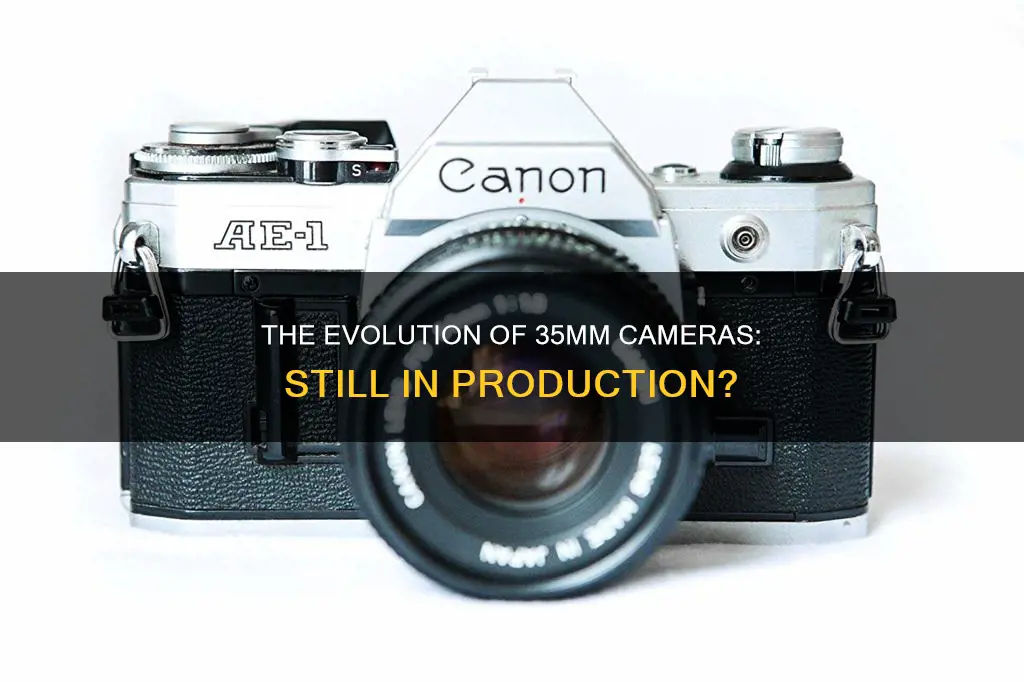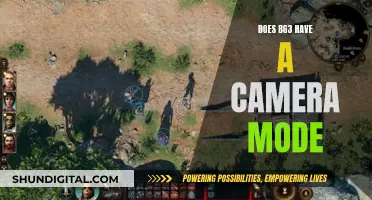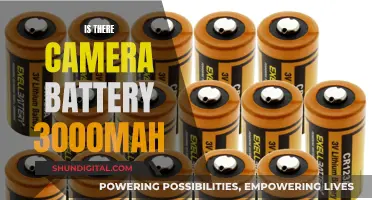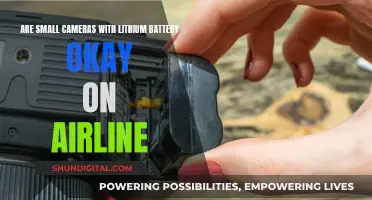
Although the list of companies still manufacturing 35mm film cameras is dwindling, there are a few manufacturers that refuse to give up on the format. Nikon, for instance, continues to produce the F6, a high-end SLR with a price tag of $2,449. Leica, another iconic brand in the world of 35mm film photography, offers three analog cameras: the MP, the M7, and the M-A (Typ 127). These cameras are known for their compact size, classic design, and quiet shutters. Additionally, Kodak and Fujifilm are still producing their classic disposable cameras, while Ilford makes a single-use camera loaded with black-and-white film. For those seeking a more creative and artsy aesthetic, Lomographic Society International offers a range of unique 35mm film cameras that prioritize creativity over quality.
| Characteristics | Values |
|---|---|
| 35mm cameras still being made | Nikon F6, Leica MP, M7, M-A (Typ 127), Kodak and Fujifilm disposable cameras, Ilford single-use camera, Lomographic Society International cameras |
| Voigtlander Bessa R2M, R4M |
What You'll Learn

Nikon FM10 SLR film camera
The Nikon FM10 is a 35mm film camera with a manual focus and SLR design. It was first introduced in 1995 and was sold by Nikon Corporation. The camera is manufactured by Cosina in Japan and is derived from the Cosina CT-1 chassis.
The FM10 is a mechanically controlled manual focus SLR with manual exposure control. It does not require batteries to operate, except for the light metering information system. The camera has a shutter speed range of 1 to 1/2000th of a second, with a flash X-sync of 1/125th of a second. Its dimensions are 139 x 86 x 53 mm, and it weighs 420 grams. The camera is finished in black with champagne chrome trim.
The Nikon FM10 was originally intended for sale in developing Asian markets but was later sold in Western countries as well. It was introduced to meet the needs of the burgeoning South and East Asian amateur photographic markets, where Nikon cameras were renowned for their high quality and durability but were expensive. The FM10's limited features and use of relatively dated technology were designed to keep production costs and prices low. Despite some criticism regarding its quality, the FM10 has proven popular as an entry-level camera for beginners and photography students.
In January 2006, Nikon announced its decision to focus on digital cameras, discontinuing most of its film-based camera bodies. The FM10 and the high-end F6 became the sole remaining film SLRs carrying the Nikon name. However, by mid-2022, the FM10 was marked as "discontinued" on multiple Nikon sites.
Understanding Camera's Antishake Mode: How It Works
You may want to see also

Leica M7 rangefinder 35mm film camera
The Leica M7 is a 35mm electronic camera produced by the German company Leica Camera AG. It is one of the few film cameras still being made today, along with the Nikon F6, the Leica MP, and the Leica M-A (Typ 127). The Leica M7 is a compact rangefinder camera with a classic design and a quiet shutter. It is known for its build quality and outstanding performance, and is a popular choice among photojournalists and avant-garde artists.
The Leica M7 offers both manual and electronic control, with an on/off switch to activate the electronic functions. It features a stepless automatic shutter speed control with metered value storage, allowing for semi-auto shots in Aperture Priority mode. The cloth focal plane shutter has been updated to an electronic version, controlling exposure time silently and accurately. The Leica M7 also includes a unique LED integrated into the viewfinder, displaying 33 different readings to keep photographers informed.
The Leica M7 can be used with a wide range of Leica lenses and accessories. It utilizes a bayonet mount and is compatible with Leica M series lenses ranging in size from 21-135mm. The camera is available in two colours: black and silver.
The Leica M7 is a highly regarded camera, with a reputation for its immersive shooting experience, robust construction, intuitive controls, and precise rangefinder. It is a valuable choice for film photography enthusiasts and professionals, offering unparalleled handling and performance.
Diagnosing Camera Battery Issues: Is It Time for a Replacement?
You may want to see also

Nikon F6 SLR 35mm film camera
The Nikon F6 is a 35mm film single-lens reflex (SLR) camera body manufactured by Nikon between 2004 and 2020. It was the sixth film camera in Nikon's 35mm F-series SLR line-up and the last remaining film SLR in production when it was discontinued in October 2020.
The F6 is compatible with every Nikon lens made since 1977, including all Nikon F-mount lenses with full metering functionality (excluding non-AI). The camera features a hybrid metal body, with the front, top, and bottom covers made of magnesium alloy, and the rest of aluminium alloy. It also has interchangeable focusing screens, with seven types available.
The Nikon F6 has an 11-point Multi-CAM 2000 AF system, with 3D Color Matrix Metering, and 5.5 fps continuous shooting (or up to 8 fps with the optional MB-40 grip). It has 41 custom settings and records your camera settings (EXIF data) to a CF card.
The F6 is a high-end camera, with a price tag of $2,449. It is the most technologically advanced 35mm film camera ever produced, with advanced exposure metering and autofocus features.
Best Buy's Camera Battery Charger Options Explored
You may want to see also

Voigtlander Bessa R4M rangefinder 35mm film camera
The Voigtlander Bessa R4M is a 35mm rangefinder film camera, which is currently in production by Cosina in Japan. It is a compact and lightweight camera, ideal for handheld low-light conditions. The Bessa R4M has a bright viewfinder, a quiet shutter, and a simple LED metering system. It features a mechanical shutter release, which means it can be used without batteries, although you will lose the metering function.
The Bessa R4M has a vertical-travel electronic metal focal plane shutter and a bayonet Leica M-type lens mount, which accepts 39mm screw-mount lenses from Canon, Leica, and Voigtlander, as well as M bayonet-type lenses from Leica, Minolta, and Konica. It is also compatible with the Voigtlander Trigger Winder for speedy, battery-free film advance and dioptric correction lenses from the Nikon FM3A camera.
The Bessa R4M has a viewfinder designed specifically for wide-angle lenses, with built-in parallax projected framelines for 21, 25, 28, 35, and 50mm lenses. This means you can frame and focus directly from the built-in viewfinder, without needing an external viewfinder. The viewfinder has a magnification of 0.52 and features a split-image rangefinder patch and brightlines for 21/35, 28, and 25/50mm lenses.
The Bessa R4M has a shutter speed of 1/2000th - 1 second, with flash sync at 1/125th second. It has a maximum flash sync speed of 1/125 and a maximum shutter speed of 1/2000, with a bulb setting for longer exposures. The camera uses two 1.5-volt LR44 alkaline batteries to power the TTL center-weighted light meter, but it can operate without batteries.
The Voigtlander Bessa R4M is a well-regarded 35mm film camera, offering a compact and lightweight design, a bright viewfinder, and compatibility with a wide range of lenses. It is a good choice for photographers looking for a compact and unobtrusive camera, particularly those interested in wide-angle photography.
Alone: Keeping Cameras Charged for Long-Term Survival
You may want to see also

Lomography Diana F+ lomo film camera
The Lomography Diana F+ is a medium format film camera with flash, inspired by the cult 1960s 60mm Diana camera. It features a retro-styled electronic flash and a removable lens, and offers a super-small aperture for pinhole images. It also has two image formats (12 or 16 square shots on a standard 120 roll), an endless panorama feature, and both a standard tripod thread and shutter lock for easy shake-free long exposures.
The Diana F+ has an average rating of 4.1 out of 5 stars on Amazon, with 144 ratings. Customers like the quality of the camera, and say it's a simple device with high-quality images that creates an interesting and artistic vignette. They also find it fun and simple to use, and a great way to experiment with photography. However, some customers have reported issues with durability, saying that the camera is made of plastic and could easily break.
The Diana F+ has a little sister, the Diana Mini, which provides a whole new Diana experience. There's also the Diana Baby, a pocket-sized version of the Diana.
Lomography also offers a multitude of Diana clones, continuing in the tradition of the original Diana.
Maximizing Camera Battery Life: Tips and Tricks
You may want to see also
Frequently asked questions
Yes, there are a few new 35mm cameras still being made, including the Nikon F6, the Leica MP, the M7, the M-A (Typ 127), the Nikon FM10, the Leica M7, the Voigtlander Bessa R4M, and the Lomography Diana F+.
There are many good second-hand 35mm cameras available, including the Canon AE-1, the Nikon FE, the Pentax K1000, the Canon T90, the Olympus Stylus Epic, the Minolta XD7, the Canonet G-III QL17, the Pentax MX, the Nikon FM3a, the Pentax Spotmatic, the Canon EOS 50E, the Minolta Maxxum 9000, the Canon EOS 1V, the Contax 167MT, the Minolta 800Si, the Pentax KX, the Canon T70, the Ricoh GR, the Contax G2, the Canon A1, the Nikon F2, the Pentax ME Super, the Hasselblad 500C/M, the Mamiya RB67, the Nikon F, the Canon AE-1 Program, the Pentax K1000, the Leica MP, the Canon AF35ML, the Nikon FM-10, the Voigtlander Bessa R2M, the Voigtlander Bessa R4M, and the Holga 135BC.
Film photography has made a comeback in recent years, largely driven by Instagram and sites like Analogue Wonderland. Many photographers enjoy the physical permanence of film, the excitement of trying different film stocks, and the sense of delayed gratification that comes with the delay between pressing the shutter and seeing the image captured. Film cameras are also often built with metallic durability that is superior to the disposable plastic of today. Additionally, film cameras can help photographers improve their skills by forcing them to pay attention to every detail before pressing the shutter button.







